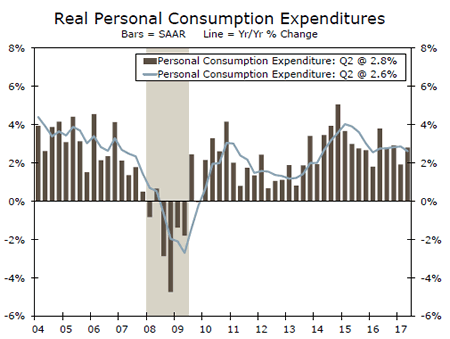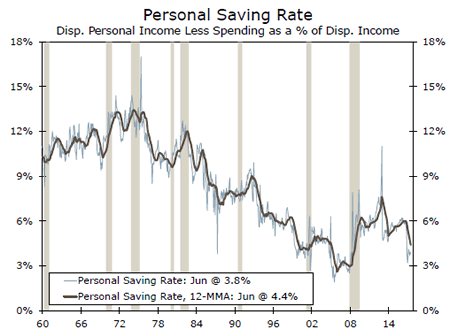U.S. Review
U.S. Economic Data Mixed This Week
- Retail sales provided the most positive piece of economic news in the United States this week. Sales topped expectations in July and, coupled with upward revisions to prior months, suggest a stronger pace of consumer spending than originally believed.
- Housing starts in July were a disappointment, however, as both starts and permits fell on the month. Starts have fallen in five out of seven months this year.
- Industrial production growth also came in below consensus in July, with much of the weakness concentrated in motor vehicles & parts.
U.S. Economic Data Mixed This Week
Economic data in the United States this week started out on a solid note with a robust retail sales print on Tuesday. Retail sales rose 0.6 percent to kick off the third quarter, topping expectations for a 0.3 percent gain. The strength in retail sales was broad based, with motor vehicle and parts dealers’ sales increasing 1.2 percent and building material & garden equipment & supplies dealers’ sales increasing 1.2 percent after registering a 1.1 percent gain in June. Even department stores sales, a sector that has been negatively affected by the eruption of online sales, posted a strong 1.0 percent increase for the month.
Perhaps equally as important, both June and May’s data were upwardly revised, signaling that growth in July was faster off a higher base. This signals that, not only was personal consumption growth likely stronger in Q2 than initially reported in the advance GDP release, but expectations for personal consumption growth during Q3 are likely to be revised higher as well. For more on the consumer sector, see our Topic of the Week on page 7.
Despite a robust reading on home builder confidence on Tuesday, housing starts data released the next day for July were a disappointment. Starts declined 4.8 percent in July and have fallen in five of the past seven months. However, much of the weakness has been in the multifamily component, which should not be surprising given slowing fundamentals. Year-to-date, single-family starts are up 11.0 percent compared to the first seven months of last year. However, single-family starts still have not risen nearly as much as builder confidence has, reflecting the greater difficulty builders are having obtaining lots and labor relative to past cycles.
The minutes from the July FOMC meeting suggested that the Fed remains on track to announce balance sheet normalization plans at its September meeting. The message in the minutes on inflation was mixed. On the one hand, "many participants" noted that much of the recent decline in inflation had probably reflected idiosyncratic factors. On the other, "several" participants indicated that the risks to inflation were tilted to the downside, while participants "differed" in their assessments of whether inflation expectations were well anchored. The inflation readings over the next few months will likely determine whether or not the Fed elects to once again cap the year with a December rate hike.
Like housing starts, industrial production growth in July was underwhelming. Manufacturing output, which comprises three quarters of total industrial output, fell 0.1 percent on the month. The automobile sector was a key driver of the miss, with monthly output declining 3.6 percent. Seasonal factors can sometimes wreak havoc on the July figures in this sector due to summer shutdowns at auto plants, but the fourth decline in five months suggests a genuine downward trend in production rather than just seasonal noise. Through the monthly volatility, manufacturing production as a whole is up 1.3 percent on a yearover- year basis, consistent with our forecast for modest but steady growth in the sector more broadly.
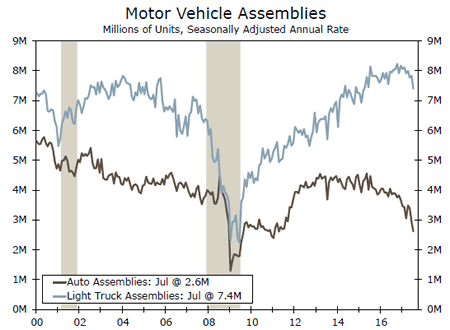
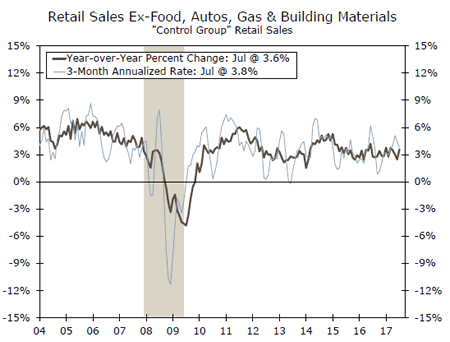
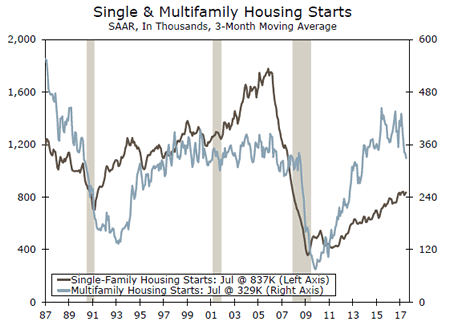
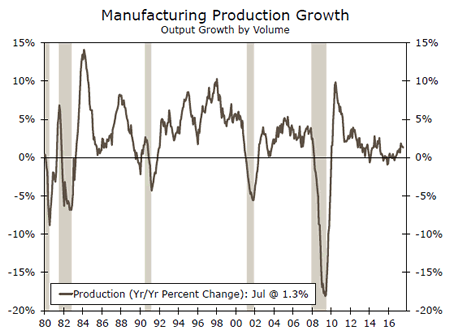
U.S. Outlook
New Home Sales • Wednesday
The modest rise in new home sales in June was encouraging, with a 0.8 percent increase to a 610,000-unit pace. Revisions to earlier months removed 27,000 sales, however, which dulled the June reading. On the bright side, some readings suggest inventory pressures eased slightly. Inventory of homes for sale rose, and the median price fell 4.2 percent—which resulted from a shift toward lower-priced homes benefiting first-time homebuyers. Most of the increase in June was for homes that had not yet started construction.
Construction of new residential homes provided a major boost to economic growth in the first quarter, but was softer in Q2 GDP. Much of this data story resulted from unusual weather patterns and the associated correction. Residential investment in the third quarter should be more supportive to GDP growth, as demand for new homes remains solid.
Previous: 610K Wells Fargo: 617K Consensus: 610K
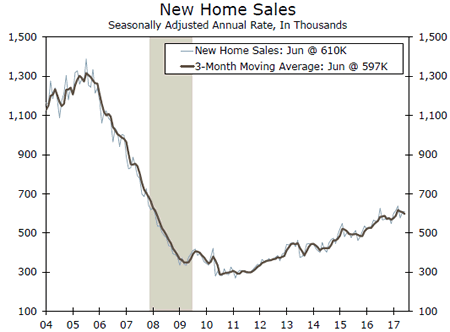
Existing Home Sales • Thursday
Persistently lean inventories continued to restrain resales in June, with existing home sales falling 1.8 percent to a 5.52 million-unit pace. We noted last month that the housing market appears to be woefully out of balance. Would-be homebuyers face a dearth of available inventory, particularly at lower price points. Developers are optimistic about demand for new stock, but available lots are lacking amid increasingly prohibitive construction costs, which are exacerbated by a shortage of construction labor. These pressures not only inhibit new home sales, but existing homeowners are understandably reluctant to put their homes on the market and risk not finding trade-up homes in their price range. Home prices continue to reach record highs.
July may have proved more conducive for homebuyers as pending sales rose in June, which tend to lead existing sales by 1-2 months.
Previous: 5.52M Wells Fargo: 5.49M Consensus: 5.56M
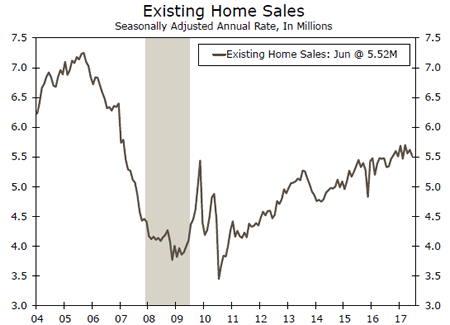
Durable Goods • Friday
The headline reading on durable goods orders in June was skewed to the upside by the notoriously volatile aircraft component, which bumped the monthly gain to 6.4 percent in June. Boeing orders were down in July, which suggests headline durable goods orders growth will likely follow suit. Excluding transportation, orders rose 0.2 percent in June while May was revised up to 0.6 percent. Core capital goods, ex aircraft, fell 0.1 percent after a strong May gain. Core goods shipments were also soft in June, and both were running at the softest 3-month annualized pace of 2017.
Worth noting is that looking beyond the aircraft component, factory sector conditions have been largely stable in recent months. Our call for a slow and steady positive trend continues to play out in the data.
Previous: 6.4% Wells Fargo: -6.1% Consensus: -5.8% (Month-over-Month)
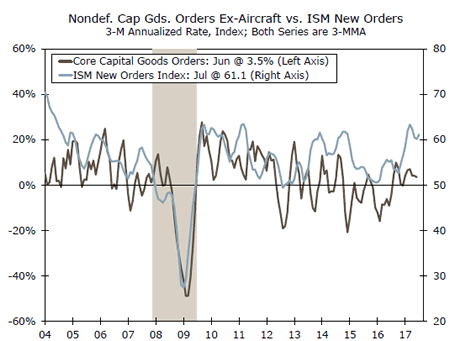
Global Review
You Can Go Your Own Way
- For the past several years, the world’s major central banks have broadly embraced very accommodative monetary policy. More recently, policy has started to go in different directions.
- In this week’s Global Review, we break down the latest figures on inflation for the United Kingdom and Canada and the second quarter GDP number for Japan, and we consider what these numbers mean in the context of monetary policy for these different corners of the global economy.
Central Banks No Longer All on the Same Page
Japan’s economy expanded at an annualized pace of 4.0 percent in the second quarter, and in so doing it extended the number of consecutive quarterly expansions to six—the longest winning streak in more than a decade.
Domestic demand picked up substantially in the second quarter as growth was driven by consumer spending as well as business fixed investment spending. Both components posted their largest quarterly increases in years and together boosted the headline GDP growth rate offsetting a modest drag from trade.
The Bank of Japan (BoJ) is not quite in synch with the world’s major foreign central banks at present. The Fed is in a rate tightening cycle, the Bank of Canada raised rates in July with another hike expected this year. The European Central Bank is widely expected to announce plans to dial back its asset purchase program as early as this autumn. Despite this backdrop, which can be collectively described as "less accommodative," the Bank of Japan has not budged in terms of its intended course.
At its July meeting, the BoJ made no change to that stance and even lowered its inflation forecast. As we describe in the international outlook section on the next page, CPI figures for July will print next week. With inflation still well-below target, we do not expect the BoJ to signal any substantive change in its comprehensive package of monetary policy accommodation.
Another consideration on the topic of large central banks is the Bank of England. The Monetary Policy Committee (MPC) is also in a situation where a rate hike could be justified. Indeed, in the past few meetings, there has been growing dissent with some members expressing a desire to raise rates sooner rather than later. The main catalyst for this pressure to hike is the fact that inflation is running a little hot. This week brought the latest reading for CPI inflation in the United Kingdom, and we learned that the year-over-year rate of inflation held steady at 2.6 percent, just shy of the consensus expectation for 2.7 percent. Some of the upward pressure on prices has to do with the marked depreciation of sterling in the wake of last year’s Brexit referendum.
The MPC looks for this pass-through effect to continue to push inflation higher in the coming months and to peak at around 3 percent in October before the effect begins to fade. If the U.K.’s economy picks up over the next 18 months as we expect, the BoE could raise rates as soon as next spring.
We mentioned earlier that the Bank of Canada (BOC) is expected to raise rates again this year. The BoC targets inflation between 1 percent and 3 percent and as close as possible to the midpoint of that range. We learned this week that CPI inflation for July increased to a year-over-year rate of 1.2 percent from 1.0 percent the prior month. The BoC’s three remaining meetings are in September, October and December. The September meeting occurs just before the FOMC meeting that month, so we expect the October meeting to be the first realistic opportunity for the BoC to hike rates.
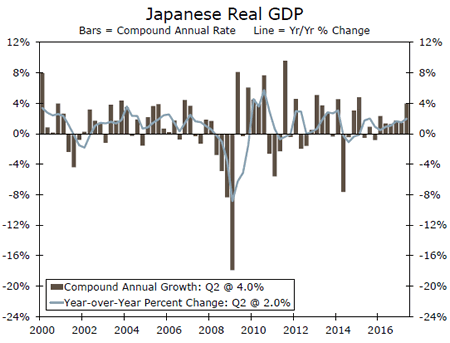
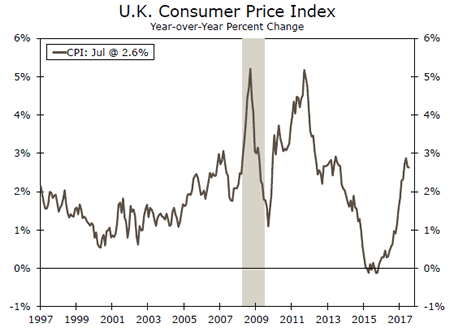
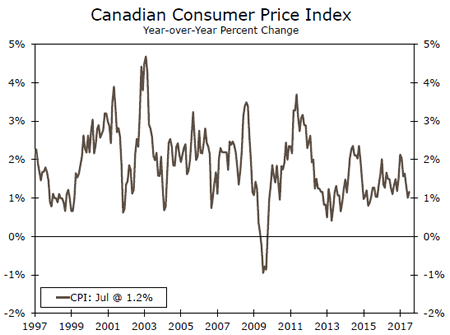
Global Outlook
Germany ZEW • Tuesday
Recent market uneasiness regarding a potential slowdown in the German economy will probably be put to the test when the August ZEW index is released on Tuesday. Although the current situation index slipped marginally, from 88.0 in June to 86.4 in July, data on the German economy have remained relatively strong lately. Thus, an improvement in the August reading will help cement the notion that the German economy remains in good shape. Meanwhile, the ZEW expectations index has weakened since June. After a 20.6 reading in May, the index printed 18.6 in June and 17.5 in July. This weakening probably helped to make the case of a slowdown in the German economy. Thus, a rebound for this index in August would be a positive sign for the German economy as well as for the Eurozone economy. On Friday, we will also get the release of the IFO business climate, current assessment, and expectations indices. This overall index recorded a series high in July.
Previous: 86.4 Consensus: 85.3
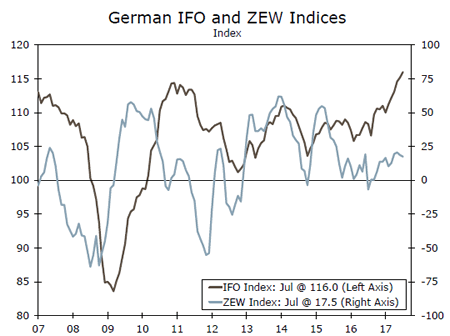
Eurozone Manufacturing PMI • Wednesday
Another index that has contributed to the view that the German and the Eurozone economies were slowing down was the Markit Manufacturing PMI index for July. After hitting an index high of 59.6 for Germany and 57.4 for the Eurozone in June, both indices came down marginally, to 58.1 in Germany and 56.6 for the Eurozone, in July. Thus, the release of the preliminary August Markit manufacturing PMI on Wednesday has the potential to move the market as a further decline in the index will help cement the slowing-down view while a recovery will tend to confirm what other data on the region have been indicating.
Markets will also have an opportunity to look at the service side of the economy, both in Germany and the Eurozone, when the services PMIs are released on Wednesday. This index hit a series high in April for the Eurozone while it has been trending down since June for Germany.
Previous: 56.6 Consensus: 56.3
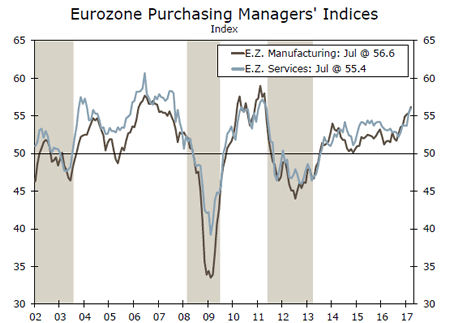
Japan CPI • Thursday
After the strong Japanese Q2 GDP reported last week, the release of the CPI number for July on Thursday will carry a little more weight than normal in a country that has had its issues with keeping inflation close to or above its pledged target of 2 percent. The yearover- year CPI rate has stabilized at 0.4 percent since April of this year and our forecast July is for the rate to remain unchanged at 0.4 percent.
Thus, as we argued on our report "Q: What G-7 Economy had Fastest GDP Growth in Q2? A: Japan," which is available on our website, we do not expect the Bank of Japan to change its view regarding monetary policy any time soon even if other developed countries’ central banks have either started to take monetary accommodation away or are moving in that direction.
Previous: 0.4% Wells Fargo: 0.4% Consensus: 0.4% (Year-over-Year)
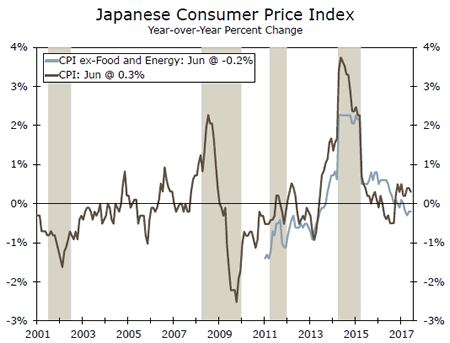
Point of View
Interest Rate Watch
It Is Beginning to Feel Like August
Hot, muggy weather and daily thunderstorms are not the only things August is known for. Financial market volatility also tends to increase and did once again, as new questions about U.S. political leadership and the future course of fiscal policy have been added to questions about an impending shift in monetary policy, both in the U.S. and abroad, despite persistent low inflation around much of the globe. As if this were not enough, Thursday’s dreadful terrorist attacks in Spain reminded everyone of the ever present geopolitical concerns hanging over the global economy and financial markets.
Bond yields pulled back, as stock prices sold off on Thursday. Economic data have, for the most part, come in on the strong side. One notable exception is motor vehicle sales and production, which have weakened due to an onslaught of used vehicles hitting the market and some deterioration in household finances. Home sales and new home construction also remain disappointing, largely due to supply constraints and the winding down of the apartment boom. Inflation remains perplexingly low, despite a tightening labor market and weakening dollar.
Bond yields declined this week, as rising geopolitical concerns and Thursday’s sharp sell-off in equity prices triggered a flight to safety. Minutes from the Fed’s September FOMC meeting raised additional doubts about whether the Fed will raise the federal funds rate again in 2017 but appear to confirm that most FOMC members remain firmly committed to beginning to draw down the Fed’s balance sheet this fall.
Fed Chair Janet Yellen should provide some additional insight into the Fed’s intentions when she speaks at the Kansas City Fed’s annual Jackson Hole shindig, which is focused this year on "Fostering a Dynamic Global Economy." Her remarks will center on promoting financial stability. The Jackson Hole conference will be the highlight of a light week of economic data but likely will not change views on the timing of the Fed’s next move or give new insights into the Fed’s plans for unwinding their balance sheet.
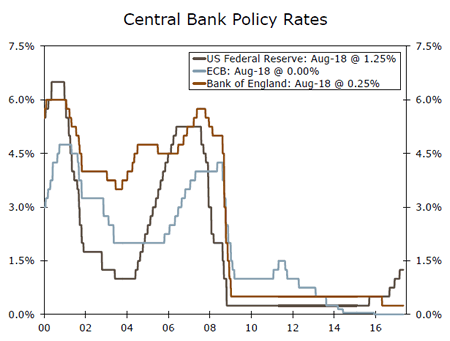
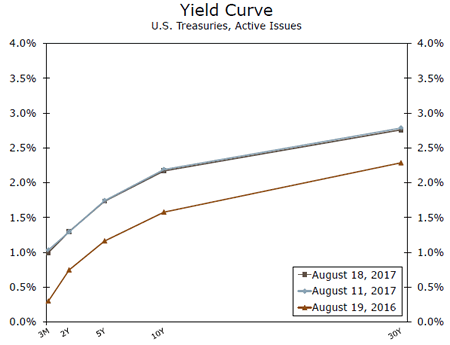
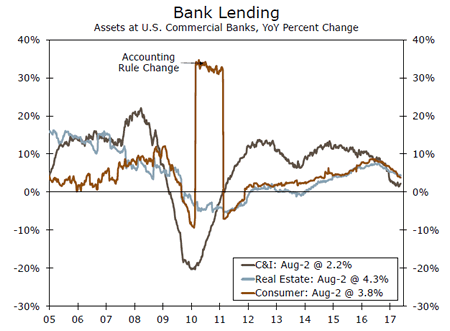
Credit Market Insights
Mortgage Credit Growth Continues
Recently released data from the Mortgage Bankers Association (MBA) showed a 0.3 percent increase in the Mortgage Credit Availability Index for July. Updated underwriting standards for adjustable-rate mortgages (ARMs) have pushed their availability closer to that of traditional mortgages, helping drive the increase for the month according to the report.
Both fixed and adjustable mortgage rates have increased over the past year; however, adjustable rates are typically lower than fixed rates. As home prices continue to climb while inventories remain low, this rate differential could be pushing borrowers to forego fixed rates for lower adjustable rates. The MBA’s Mortgage Application Survey supports this shift, with ARMs at 15 percent of the total value of loan applications for the week of August 11th, up 28 percent year-over-year.
While mortgage credit continues to grow, mortgage delinquencies are maintaining their downward trend, now at only 1.5 percent of balances at least 90 days past due in Q2, compared to almost 9 percent in 2010. Lower delinquencies may position borrowers to better withstand rate increases on the horizon, especially for those with ARMs sensitive to interest rate changes. We look for one more Fed rate hike in 2017 and three in 2018. Data to be released next week on new and existing home sales should reinforce the extent to which mortgage credit growth is displayed in the housing market as of late.
Topic of the Week
Consumers Tap Rainy Day Fund
Consumer confidence surged after the surprise U.S. presidential election result last fall. The Conference Board’s consumer confidence index soared roughly 25 percent between October 2016 and March 2017, with much of the gain coming in the expectations component. This shift in sentiment suggested consumers were poised to ramp up their spending in the first half of the year. Despite the gain, real personal expenditures growth was ho-hum in the first half, continuing to trudge along at roughly 2.5 percent year-over-year (top chart). Was the surge in confidence a false start?
To keep consumption growth humming along, consumers dipped into their savings. The personal savings rate fell from 5.7 percent in September 2016 to 3.8 percent in June 2017 (bottom chart). Consumers had been keeping their powder dry heading into the end of last year and evidently felt confident enough to alter their saving behavior in the wake of the election. This drawdown can only keep growth going for so long, however, and if employment growth gradually slows over the next year, as we expect, it will take fatter paychecks to keep growth steady in the consumer sector.
Wage growth has been a perennial challenge in this cycle, and with slack in the labor market continuing to diminish, continued weak income growth presents a significant risk to the outlook. Personal consumption accounts for about 70 percent of GDP, making it far and away the largest component of the economy. As a result, the outlook for the consumer will play a key role in driving economic growth in the quarters ahead. For now, our outlook is for personal consumption growth to be more or less stable during the second half of the year. Retail sales kicked off the third quarter on a positive note, and average hourly earnings growth was solid in July, encouraging signs for second half activity.
